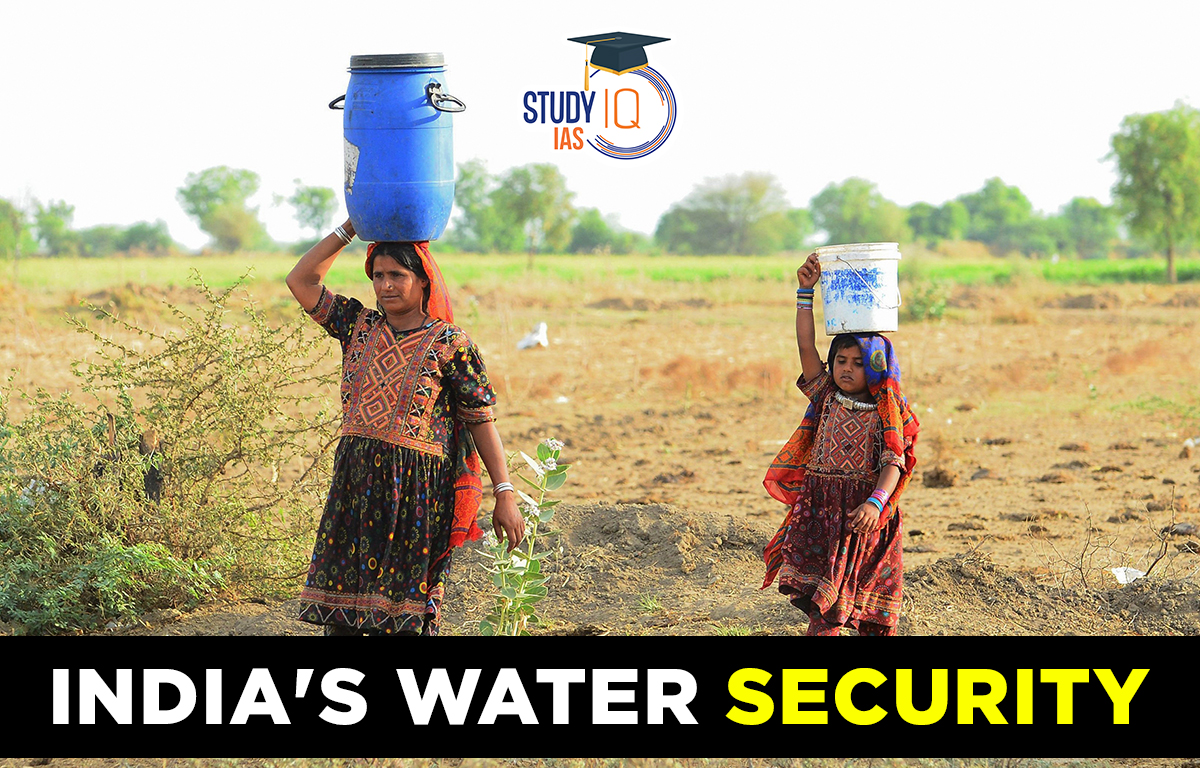Table of Contents
Context: Recently, the Prime Minister flagged water security as a major concern and called for the revival of the country’s “emotional connection” with nature to attain “sustainable development”.
Introduction to India’s Water Security
- Water Availability: India is home to 18% of the worldwide human population and 15% of the worldwide animal population. However, it has just 4% of worldwide freshwater assets.
- Water Stress: India is classified as a water-stressed country, with per capita water availability decreasing over the years.
- In terms of per capita water availability, India ranks 133rd out of 180 countries in 2021 with 1,544 cubic meters per year per person.
- According to the Composite Water Management Index (CWMI) report of 2019, around 75% of households in India do not have access to drinking water at their premises, and 70% of the country’s water is contaminated.
- Increasing Water Demand: Urban water demand in India is projected to increase from 42 billion cubic meters in 2000 to 74 billion cubic meters in 2050. This increase in demand is due to the growing population, increased urbanization, and rising incomes.
- Groundwater depletion: India is the largest user of groundwater with a fourth of the total global withdrawal. Indian cities cater to about 48% of its water supply from groundwater. The overall stage of groundwater extraction in the country is 60.08%.

What are the Major Challenges Regarding Water Management in India?
- Water Pollution: India’s water resources are heavily polluted, with industrial and agricultural waste, as well as untreated sewage, being discharged into rivers and other bodies of water.
- According to a report by the Central Pollution Control Board, only 37% of India’s wastewater is treated before being discharged into rivers.
- Inefficient water usage: Agriculture accounts for around 80% of India’s water consumption, with irrigation being the largest user of water.
- However, traditional irrigation practices like flood irrigation and open canals are highly inefficient, with up to 60% of the water lost to evaporation and seepage.
- Moreover, the water use efficiency of crops in India is also relatively low compared to other countries, mainly due to the use of low-yielding crop varieties, inadequate soil and water management practices, and insufficient adoption of modern irrigation technologies.
- Unregulated groundwater extraction: Groundwater, regarded as a “common pool resource”, has historically witnessed little control over its extraction.
- About 87% of total annual groundwater extraction is for irrigation use in agriculture.
- Climate Change: India’s water resources are also affected by climate change, with changing rainfall patterns and increasing frequency and intensity of droughts and floods.
- According to the Climate Risk Index 2021, India is the seventh-most vulnerable country to the impacts of climate change.
- Water management policies and governance: There is a lack of effective water management policies and governance in India, with fragmented institutional arrangements, weak regulatory frameworks, and inadequate enforcement of water laws.
Steps taken for the Effective Water Management and Promoting Water Security
| Jal Jeevan Mission | It Is Envisioned To Provide Safe And Adequate Drinking Water Through Individual Household Tap Connections By 2024 To All Households In Rural India. |
| Jal Shakti Abhiyaan | It Was Launched In 2019, A Time-Bound Campaign With A Mission Mode Approach Intended To Improve Water Availability Including Groundwater Conditions In The Water-Stressed Blocks Of 256 Districts In India. |
| Jal Kranti Abhiyan | Focuses On Active Efforts To Revolutionize Villages And Cities Through Block-Level Water Conservation Schemes. |
| National Water Policy | The Policy Advocates Rainwater Harvesting And Conservation Of Water And Highlights The Need For Augmenting The Availability Of Water Through Direct Use Of Rainfall. |
| National Water Mission | Aims To Conserve Water, Minimize Wastage And Ensure More Equitable Distribution Both Across And Within States Through Integrated Water Resources Development And Management. |
| Groundwater Legislation | Ministry Has Circulated A Model Bill To All The States/Uts To Enable Them To Enact Suitable Groundwater Legislation For The Regulation Of Its Development, Which Also Includes The Provision Of Rainwater Harvesting. So Far, 19 States/Uts Have Adopted And Implemented Groundwater Legislation. |
| Atal Bhujal Yojana (Abhy) | It Is An Rs.6000 Crore Scheme With World Bank Funding, For Sustainable Management Of Groundwater With Community Participation Is Being Taken Up In The Identified Over-Exploited And Water-Stressed Areas. |
| National Water Awards | Organized By The Department Of Water Resources, River Development And Ganga Rejuvenation, Ministry Of Jal Shakti. Focus On The Good Work And Efforts Made By Individuals And Organizations Across The Country, And The Government’s Vision For The Path To Jal Samridh Bharat. |


 Daily Quiz 05 July 2025
Daily Quiz 05 July 2025
 SSC MTS Apply Online for 1075 Posts – ...
SSC MTS Apply Online for 1075 Posts – ...
 Dynamic Pricing: What It Is and Why It's...
Dynamic Pricing: What It Is and Why It's...





















